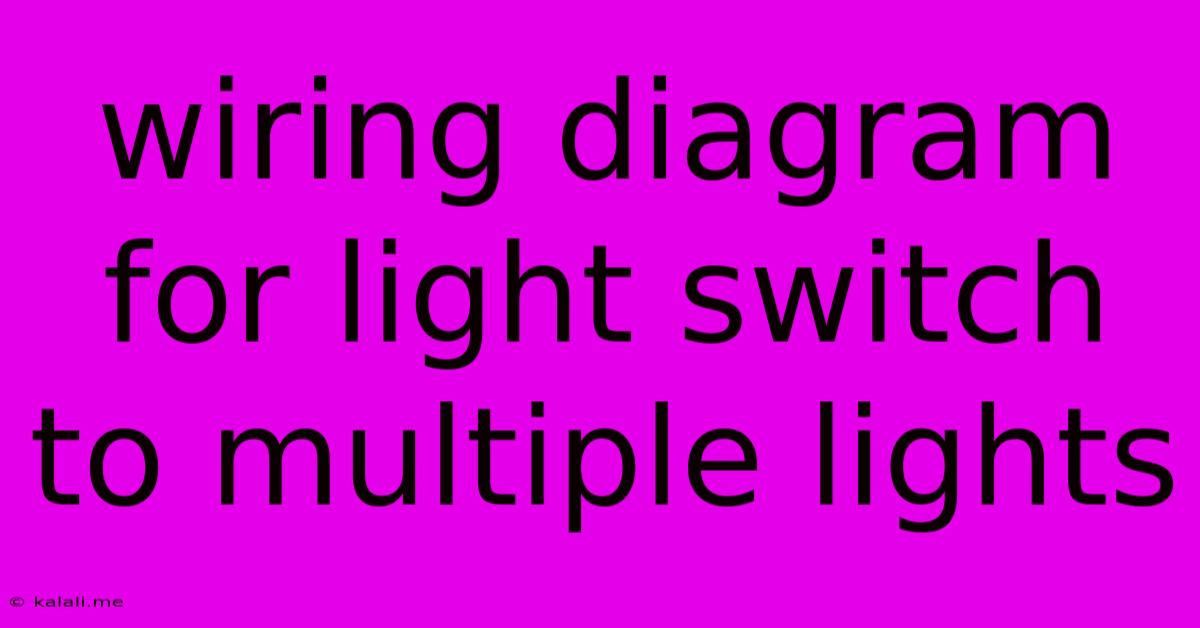Wiring Diagram For Light Switch To Multiple Lights
Kalali
May 31, 2025 · 4 min read

Table of Contents
Wiring a Light Switch to Control Multiple Lights: A Comprehensive Guide
This guide explains how to wire a single light switch to control multiple lights, a common home wiring project. Understanding basic electrical safety and having some experience with wiring is crucial before attempting this. Always turn off the power at the breaker box before starting any electrical work. Improper wiring can lead to electrical hazards and potentially fire. This article provides a general overview; always consult local electrical codes and regulations.
This project involves understanding parallel wiring, where each light fixture receives power independently from the switch, ensuring one switch controls multiple lights simultaneously. We will cover different wiring scenarios and troubleshooting tips.
Understanding the Basics: Parallel Wiring for Multiple Lights
Unlike a series circuit, where lights are wired one after another, a parallel circuit provides independent power to each light. This means one light failing won't affect the others, and each light operates at its full wattage. In this setup, each light receives power directly from the power source, with the switch controlling the flow of electricity to each light. This is achieved by connecting all the lights' "hot" wires to the switch and then connecting the switch's other side to the power source. The neutral wires are connected together directly to the power source.
Materials Needed
- Light Switch: A standard single-pole switch will suffice. Consider a dimmer switch if you want adjustable brightness.
- Electrical Wire: Use wire with a gauge appropriate for your lights' wattage. Consult your local electrical codes for specifics.
- Junction Box: You'll need this to connect the wires from the various light fixtures.
- Wire Connectors (Wire Nuts): For securely joining wires.
- Voltage Tester: Essential for verifying power is off and for troubleshooting.
- Screwdrivers: Phillips and flathead, appropriately sized for your switch and junction box.
- Electrical Tape: For added insulation (though wire nuts should suffice).
Steps to Wire a Single Switch to Multiple Lights
-
Turn Off the Power: This is the most crucial step. Switch off the breaker controlling the circuit you're working on at the breaker box. Verify with a voltage tester that the power is indeed off before proceeding.
-
Locate the Junction Box: Identify the location where you'll connect the wires from your lights. You might need to install a new junction box if one doesn't exist conveniently.
-
Connect the Neutral Wires: Connect all the neutral wires (usually white) from the lights together using wire connectors (wire nuts). This bundle of neutral wires will then connect to the neutral wire from your power source.
-
Connect the Hot Wires (Switched Wires): Connect the hot wires (usually black) from each light fixture to one of the terminals on the light switch.
-
Connect the Hot Wire from Power Source: Connect the hot wire from your power source to the other terminal on the light switch.
-
Grounding: Connect all the ground wires (usually bare copper or green) together using a wire connector. Securely connect this bundle of ground wires to the ground terminal on the switch and the junction box.
-
Secure Connections: Ensure all wire connections are tight and well-insulated. Use wire nuts securely to avoid loose connections which can create fire hazards.
-
Mount the Switch and Lights: Mount the switch in its designated location and re-install the light fixtures.
-
Turn On the Power: Once everything is securely connected, turn the power back on at the breaker box.
-
Test the Lights: Test each light individually to verify they are working correctly and controlled by the switch.
Troubleshooting
- No Lights Working: Check the power at the breaker and verify all wire connections at the switch and junction box.
- One or More Lights Not Working: Inspect the wiring of the malfunctioning lights and ensure all connections are secure.
- Switch Doesn't Control All Lights: Verify that all the "hot" wires from each light fixture are correctly connected to the switch.
Remember, safety is paramount. If you are uncomfortable with electrical wiring, consult a qualified electrician. This guide is for informational purposes only and does not substitute for professional electrical advice. Always follow local building codes and safety regulations.
Latest Posts
Latest Posts
-
Fallout 4 The Freedom Trail Code
Jun 02, 2025
-
What Is A Medium In Waves
Jun 02, 2025
-
Microscope How Much Magnification Do I Need For Various Things
Jun 02, 2025
-
Do She Hulk Have The Unlimited Strength As The Hulk
Jun 02, 2025
-
How To Weigh Something Without A Scale
Jun 02, 2025
Related Post
Thank you for visiting our website which covers about Wiring Diagram For Light Switch To Multiple Lights . We hope the information provided has been useful to you. Feel free to contact us if you have any questions or need further assistance. See you next time and don't miss to bookmark.